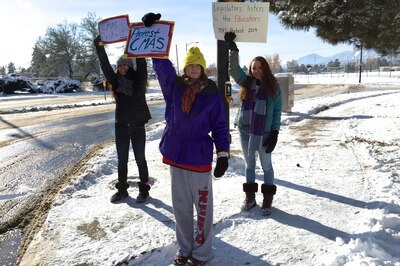Two large Colorado school districts with substantial numbers of students living in poverty — Denver Public Schools and Aurora Public Schools — showed modest improvement in the second year of state tests measuring students’ mastery of tougher academic standards.
Despite those gains, both districts still lag behind the state average — and in Aurora’s case, the gap is substantial.
Overall, the state education department’s release Thursday of district- and school-level results from PARCC math and English tests amounted to a mixed bag for most, with scores creeping up in some subjects and grades, slipping in others or remaining steady.
The picture is further muddied by a lack of student growth data that measure changes in the same group of students over time — data state officials are still compiling. Low test participation rates in higher grades also call into question district and school level scores, officials concede.
The state last month released state-level 2016 PARCC results, which showed more elementary school students were meeting expectations, while middle school scores were flat.
For the first time since the state overhauled its annual testing system in 2014 to align to the politically controversial Common Core State Standards, teachers, parents and taxpayers are able to compare year-to-year results in most subjects and grades.

The results, along with other measures such as graduation rates, will determine the quality ratings of schools and districts. Those ratings will be released later this fall. For some schools, another round of poor results could mean state intervention — something that has never happened before.
Like last year, anti-testing sentiment ran highest in Boulder and wealthier suburban Denver enclaves, as well as in some rural districts. Older students were more likely to not take the tests while the overwhelming majority of younger students took them, also echoing last year’s trends.
At Boulder’s Fairview High School, just 72 of 514 ninth graders took the PARCC English test.
Joyce Zurkowski, the state’s director of assessments, said lower participation rates invite scrutiny.
“When I’m looking at a school with a high number of kids who met or exceeded expectations, with 98 percent participation, the confidence I can have in those results is higher than at a school with an even higher number of students who met or exceed expectations but had only 40 percent participation,” Zurkowski said.
The big five
Results from the state’s five largest school districts mostly mirrored statewide results, which most notably showed gains in elementary school math.
Denver Public Schools, the state’s largest school district, showed gains in all but one test. The district only lost ground in the percentage of students who met or exceeded the state’s benchmarks in seventh grade math, dropping by 2.6 percentage points. The district’s largest leap in the percentage of students who cleared the state’s benchmarks was in fourth grade English, with a jump of 5.5 percentage points.
“A decade ago, we were 25 points behind the rest of the state,” Superintendent Tom Boasberg said. “Now we’re about 3 or 4 points behind the rest of the state. Against that benchmark, we’ve made very consistent, very striking progress.”
Jeffco Public Schools, the state’s second largest school district, saw gains in math in every grade but sixth. But it lost ground across the board on the state’s English tests. Its largest drop, 6.4 percentage points, was in the ninth grade.
“We are pleased to be improving in math given the higher level expectations of the CMAS/PARCC assessments,” Superintendent Dan McMinimee said in a statement. “Reading will continue to be a focus for our district improvement planning and we won’t be satisfied until all of our students are meeting or exceeding state expectations.”
The state’s third largest school district, Douglas County, made gains in math at the elementary school level, but lost ground in middle and high school. The south-suburban school district had wild swings on the English test. Ninth graders gained 5.7 points on that test, but seventh graders lost 7 points.
Strong gains in math were made in Cherry Creek elementary schools. But sixth graders this year lost 4 percentage points. The state’s fourth largest school district had more mixed results on the English test. There was a 2.8 percentage point increase in the number of fourth graders who were at grade level in English. But there was a 2.3 percentage point drop at the eighth grade level.
Julie Skupa, Cherry Creek’s assistant superintendent of assessment and improvement, said the district could attribute its higher math scores in part to a new curriculum.
“It goes beyond knowledge and rote memorization, and requires students to do a lot of problem-solving,” she said.
Aurora Public Schools, the fifth largest school district, saw mostly improvements. Students made gains in every grade on the English test except for grades six and eight. Similarly, Aurora showed increases in the number of students who met state expectations on the math test in every grade except for sixth and seventh.
“We’re seeing the first overall increase in performance since the 2011 school year,” said Superintendent Rico Munn, who has been leading an aggressive school improvement agenda. “We hope we can attribute that to our increase in rigor and relevance, our effort to make sure we have a high-quality teaching staff, and focus on our strategic plan.”
Growing pains
Changes made to Colorado’s testing system during the 2015 legislative session — including who takes the tests and how they take the tests — complicated this year’s release. School leaders voiced their frustration over slow-to-be-released and incomplete data that in some cases can’t be used to make comparisons to last year’s results.
For starters, this year’s upper division math results can’t be compared to last year’s because different grade levels took those tests. In 2015, middle school and high school students were eligible to take the state’s most advanced math tests. However, after lawmakers eliminated testing in the 10th and 11th grades, only seventh through ninth graders were able to take those tests.

The upshot: you can’t compare results between the two years.
And for the second year in a row, Colorado has released results from its tests piecemeal. While schools are getting their results three months earlier than they did last year, the results are still slower than anyone expected.
“What they promised was that through the online system, we’d get results back sooner than later,” Skupa said, adding that it’s difficult for districts to make any meaningful changes after the school year has started. “It’s these bits and pieces that make it difficult to create a big picture view.”
Part of the slowdown this year, Zurkowski said, is that school districts were allowed to use pencil-and-paper tests on a much larger scale. But that’s only part of the problem, she said.
“I believe the PARCC consortium underestimated the complexity of scoring and reporting their assessments, especially in the first few years,” she said. “I do believe that not only Colorado but the PARCC consortium is committed to continue to find ways to improve that turnaround time.”
Paper-and-pencil tests are causing another set of concerns for the state. Last year, the state acknowledged that students who used paper tests performed better than they would have if they used online tests. Test that were impacted included the third grade English test and upper division high school math tests.
Zurkowski said that while the department has theories as to why the bump happened — students could have felt more comfortable writing out equations than keyboarding them — it doesn’t know for certain.
“There was a lot to sort through,” she said. “… Honestly, we don’t know what specifically the issue is.”
To ensure that didn’t happen this year, the state education department ran results from about 16 schools that used paper tests through a series of mathematical procedures ensuring students would get the same score whether they took the test on paper or online, Zurkowski said.
The additional steps make the results more reliable, Zurkowski said, but the department is still urging caution when it comes to looking at those schools.
“We’re not going to over-interpret at this point,” she said.
Search for your school
Use Chalkbeat’s database to search for your school’s individual results on the math and English tests. The green bar represents the number of students who met or exceeded the standards. The yellow bar represents the number of students who took the tests. State officials have cautioned that low participation rates could skew results.


